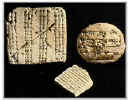Ceramic Technology: Construction of a Cuneiform Tablet Experiment Directions
In this lab we will use local clay picked up by hand
to make the malleable writing tablets that were used as erasable
“paper” for keeping records and as a blackboard for teaching students
to read and write. These
tablets were sometimes purposely baked to make a permanent record, such as
of tax revenues, or they were sometimes accidentally baked when a fire
burned the temporary (dried) tablets that were stored for later recycling.
We will make a clay tablet similar to the hand-held size so
practical and popular in the past, and we will learn some cuneiform in
order to give a flavor for the tools and methods used in this early form
of technology. It is on these
kinds of tablets that we have our record of the first two chemists; two
women perfumers from the era of the Babylonians.
1) Jump to the University
of Pennsylvania’s Museum of Archaeology and Anthropology to obtain
your monogram in cuneiform. For
your full name, a Mesopotamian syllabary such as that found in Daniels and
Brights' "The World's Writing Systems" will be used. For
your birth date, you will want to look into large cuneiform numbers at the
Mesopotamian
Math site.
2) Obtain a handful of clay from the clay bed along
Monument Creek just above the Uintah Street Bridge, or along the Section
16 Trail.
3) Shape the clay (using enough water to make it
malleable) into a tablet, and inscribe your name and birth date (in Mesopotamian
cuneiform) using a
wedge-shaped stick (reed).
4) Bake the clay in the charcoal brazier provided at the class barbeque cookout.
